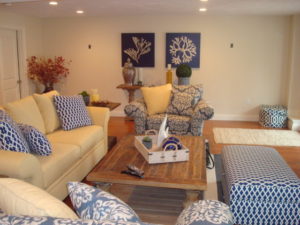
Once you’ve established a color palette into the room, you may want to use a patterned textile or wall covering that will carry more than one color. Using patterns in a room allows you to create interest and to intermingle the colors of your theme. Patterns come in three sizes, and there are rules about mixing them. The three sizes are referred to as random, regulated, and miniprints.
• Random patterns are usually large-scale with a repeat of over 20 inches.
• Regulated patterns are those that repeat in a regimented way. Examples are stripes and diamond or harlequin patterns. These will, typically, have a repeat of somewhere between 7 and 20 inches.
• Miniprints are those with a repeat of less than 7 inches. Note that, sometimes, the repeat is so small it can look like a solid color when viewed from a distance.
All three categories of patterns may be used together in a room with the following criteria:
1. The color theme is consistent. This means that the colors are mixed among the patterns.
2. Neutrals and solid colors are used as transition between the patterns.
3. As a general guideline, the random pattern (largest scale of pattern) is used on the largest area such as the walls or the sofa. This is not always the case; however, it is a good place to begin. One example: the wall covering or sofa would be a large-scale pattern; the medium size pattern (regulated)—possibly a stripe— would be placed in the window treatment, pillows, or a side chair; and the smallest pattern (miniprint) as part of the top treatment, pillows, or area rug.
4. Patterns are best spread throughout the room on the different levels (eye, mid, and floor) for balance and visual appeal.
To get more tips of how to effectively work color and patterns within your space, pick up a copy of “The Styleprint Design System” available for purchase here. Also, be sure to explore our site as well for additional free resources.






